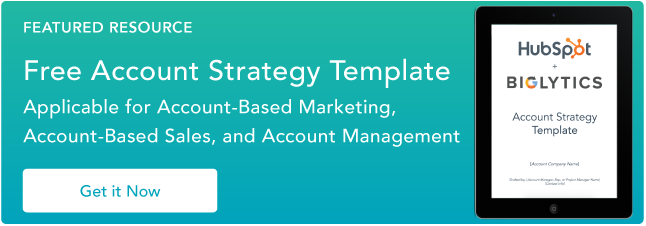Think about how much easier marketing is when you know exactly what companies to target and what marketing messages would best resonate with them. That's the dream, right?

While we don't live in a perfect world, we do live in a world where inbound marketing and account-based marketing (ABM) exist. And, when these two strategies work together, this dream can become a reality.
You may be pretty familiar with inbound marketing — creating content that attracts, converts, and delights customers.
You may also know a thing or two about account-based marketing: aligning marketing and sales to deliver a consistent, personalized buying experience for prospects. But, because of their definitions, perhaps you think you have to choose between the two.
Fortunately, you don't have to choose. In fact, instead of thinking "ABM versus inbound," you should be thinking "ABM and inbound."
To clarify, let's define the two and offer some tactics around how to work these strategies into your existing marketing campaign.
What is account-based marketing?
Account-based marketing is a highly-targeted, focused growth strategy. It works by aligning marketing and sales functions to create a personalized experience for accounts, rather than an individual buyer.
Instead of treating each of those buyers as an individual entity, ABM is a strategy that says, "Let's make sure we plan how to market and sell to all of those buyers as one account."
This starts with aligning Sales and Marketing to mutually choose a select set of accounts. Then, together they create marketing and sales strategies that target each account. This saves time for marketing and sales and delivers a far more consistent buying experience for the customers within each account.
Businesses that are typically a good fit for using an ABM strategy are those that sell high-value products or services to other businesses, like B2Bs.
The alignment of Sales and Marketing when using an ABM strategy helps you make more streamlined business decisions. It eliminates the time you would spend trying to sort out the best accounts to target, and instead, speeds up the process of delighting those prospects.
ABM treats accounts as if they're individual buyers, and because of this, you'll be able to delight the key decision-makers with a personalized content strategy.
So, ABM is a go-to strategy for shortening sales cycles, increasing ROI, and effectively selling to your highest value accounts in the way they each prefer to buy — but how is it comparable to inbound marketing? Let's talk about that next.
Account-Based Marketing and Inbound Marketing
ABM allows you to delight high-value accounts with a focused approach. Inbound marketing lets you attract customers through the creation of valuable, SEO-optimized content — it provides audiences with the information that's important to them in an organic manner.
But what do they have in common?
Both strategies require a deep understanding of your target buyer to inform what type of content you're creating & how you choose to deliver it. This increases discoverability by that target.
According to HubSpot's ABM Product Marketer, Ryan Batter, "Every growth story begins with the same foundational elements of inbound marketing — building great content, crafting a publishing strategy, optimizing search presence to enable discovery of your brand and generate leads."
You can repurpose content and use the same channels for ABM as you've already put into place with inbound. ABM is often just taking that foundational content and personalizing it even more.
Both inbound and ABM are focused on delivering a great buying experience across the entire flywheel. ABM helps accelerate the flywheel once inbound foundation is in place.
Additionally, the two strategies focus on targeted, personalized content. ABM hones in on delighting the right customers through content that is specifically created to cater to their challenges, an essential function of inbound marketing.
Finally, the two help with the happiness and retention of your customers. Because an ABM strategy focuses on a set of specific accounts, you'll have more opportunity to focus on the happiness and retention of those clients, which is another essential part of the inbound marketing flywheel.
That's not all, though — you can also use the two in a partnership to elevate your entire strategy.
"For some stories, companies benefit immensely by complementing their inbound foundation with account-based strategies that provide more personalized, tailored buying experiences for a subset of high-value leads," Batter says.
Put another way: inbound marketing helps you attract the right customers. Then, account-based marketing uses marketing and sales to speed up the process of the flywheel and provide a valuable customer experience. In the end, both strategies enable you to win those target accounts.
It's critical you approach your account-based marketing, the inbound way: provide valuable content and customer experiences to those high-value accounts.
Using the two together helps you offer a more robust strategy. Plus, software, like the HubSpot CMS, allows you to experiment with the creation of campaigns that align with your businesses' goals.
How to Do Account-Based Marketing
To ensure you keep customers at the center of your account-based marketing strategy, stick to the principles. Make your account-based marketing strategy center around tailoring the way you communicate with your target company.
There are five primary stages to account-based marketing that work hand-in-hand with inbound marketing. Let’s walk through each and detail how you can conduct ABM in a human-friendly way.
1. Identify
Account-based marketing begins with sales and marketing identifying and selecting relevant accounts. When beginning this selection process, data, such as company size, number of employees, location, and annual revenue, can give you an understanding of accounts you may want to target.
Similar to inbound marketing, you can also use buyer personas to understand the day-to-day lives and challenges of your target buyers, then determine content and channels to approach them.
2. Expand
In sales where ABM is typically used, buying decisions are generally made by numerous individuals within a company. ABM helps establish a relationship with each potential buyer and engages them in the purchase decision.
At the expand stage, creating unique, company-specific content that interests each potential buyer within the organization is important. Whether your product is for marketers, operations leaders, or anyone else, ensuring that you identify and engage with everyone in the buying decision is crucial to winning a customer.
Consider the challenges each of your stakeholders faces in order to create compelling content. For example, Finance may be concerned with pricing, while Operations might be focused on user access, ease of use, and security. With this context, you can create targeted content and interactions that match each individual's concerns and challenges.
3. Engage
Here’s where sales and marketing come together and join the party to engage with stakeholders across various channels. For example, if one of your stakeholders prefers email, then equipping salespeople to reach out to that person with a helpful and relevant message can get a conversation started. This stage is largely about developing relationships with and getting to know all the buyers who will make the final decision.
4. Advocate
Next, you want to nurture bonds with a few stakeholders who can serve as advocates within the organization. The modern buyer can tune out information they don’t want to hear. So it’s up to both marketing and sales here to provide value — and talk about the product when and where necessary.
5. Measure
Finally, reporting at the account level can give you data on what's working, what's not, and how to improve over time. With HubSpot ABM software, you can report on company growth, revenue, job titles, engagement levels, and much more — all at the account level.
For more information about how to align ABM with inbound, as well as some tactics for stellar account-based marketing tactics, be sure to check out this ultimate guide.
If you're a company that sells into a smaller addressable market and has its sights on a handful of highly critical accounts, you can learn more about building an ABM strategy without abandoning your inbound philosophy in this webinar.
Editor's note: This post was originally published in May 2020 and has been updated for comprehensiveness.











